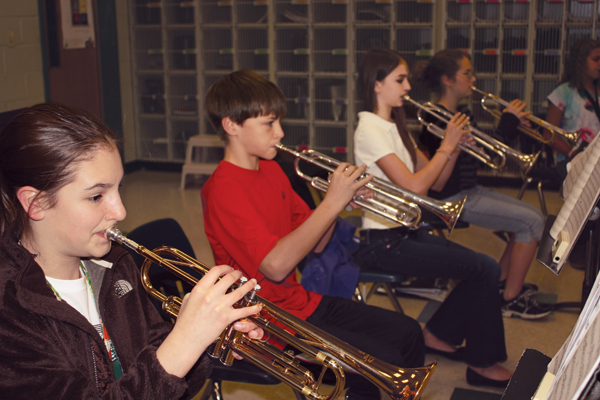
Tuning is a mystery to many. Musicologists devote years to the research of tuning, but many directors spend only ten minutes before a concert tuning and matching pitch. However, placing a tuner in front of a student and playing one or two notes before a concert is a disaster. If the band has not rehearsed in tune daily, then the musical structure, balance, chord structure, and tonal center will never be good. The sound will never be dark, full, and round, only bright and edgy. Some problems come from young soloists and ensembles playing one note and expecting to be in tune. Tuning to one note is no way to check for balance, section blend, air concepts, tone color, and adjustment of pitches to the environment.
Tuning during the Warm-up
No ensemble will play in tune without a warm-up. The best ensembles are warming up thoroughly and checking each other’s sounds and pitches constantly. The director should select a pitch that creates a dark sound and teaches balance. Half of the time, bad pitch occurs because ensemble has not been taught to play with a characteristic tone quality or listen for balance. Balance and tone quality are the root of the problem of intonation in many ensembles.
To fix these, we usually break the band into four groups. Group one consists of tubas, bassoons, bass clarinets, and baritone saxophones; group two includes trombones, baritones, horns, and tenor saxophones; group three is trumpets, alto saxophones, and second and third clarinets; and the final group has first clarinets, oboes, flutes, and piccolo. When all students in the first group are in tune, we add the next group and continue tuning and adding more until the whole band is playing. The students, when trained, will remedy many problems by exposing pitch discrepancies in this way. It is amazing the multitude of sins this process will cure without your having to say a word. A band can also be balanced to chord structures. Tune roots, add the fifth, then the third and finally the seventh, if there is one. Chords should also be balanced according to the groups above. This goes a long way in making a band sound good.
Know Pitch Tendencies
Pitch tendencies for every instrument should be taken into consideration. Tuning to concert Bb fails to take into consideration that the flute hand position will keep the pitch unstable and clarinet Cs and saxophone Gs are built sharp. It is better to tune to concert F. This puts the brass in the middle of their most frequently used range and is a comfortable note that all ages can tune without straining, pinching, or altering a good embouchure and steady airflow. Tuning brass instruments to the second partial (concert F) also allows for manageable compromise on the first and third partials. Clarinets should tune to an open G to check their reed, air stream, and mouth placement. If all this is good, then the instrument will be in tune as it came from the factory, and a student who knows the tendency of each note can adjust accordingly. A clarinetist can be moving plenty of air and play with an excellent embouchure and still have bad pitch because of an old reed. Similarly, when saxophones tune to an F#, then the instrument is pitched correctly and students can be confident about which notes are sharp or flat. Saxophonists who are consistently flat were almost certainly tuned to a concert Bb.
Look for places where woodwinds might need to use alternate fingerings and check each student and each instrument to discover if the note sounds the same with both fingerings. Be especially sure to check the oboe to see if forked and chromatic F sound the same. Make sure flute players can hear and adjust the pitch, especially in the upper register. This can be done by rolling the flute or altering the jaw.
Tune every valve slide on every brass instrument. The trumpet notes D4 and C#4 will be sharp unless the third valve slide is extended. It is not enough to simply move the slide out. Students should discover how much of the slide to use, then practice extending the valve slide that distance until the motion is habitual. Help trumpet players to figure out if they need to adjust the first valve slide on F5 or A5. Not every trumpet requires this. Similarly, tuba players with three-valve instruments should practice when and how much to adjust valve slides for C2 and B2. Trombone players who have an F attachment should check the pitch of notes that require the trigger. Horn players should use the hand to adjust every note as needed. Students with double horns will need instruction on when to switch to the Bb side of the instrument. Attentive brass players are aware of the tessitura for each line and can adjust accordingly. If they cannot play a line slowly in tune, then they will never play it quickly in tune. Mouthpiece buzzing helps the muscles in their face to know the line; the horn is only an amplifier. It is best to avoid playing at full tempo on the first reading of a piece. This will only frustrate students and cause them to practice mistakes. Give brass players adequate time to find spot-on pitches.
If clarinets have a G6 in unison with flutes on F6, clarinetists should adjust to the flutes. There are more than 10 fingerings for G6; clarinetists should be able to find one that matches the flutes.
Clarinets are sharp on written C4, and alto saxophones are extremely sharp and bright on written B4, which sounds a major third higher than clarinets playing the C4. This orchestration can be wildly out of tune. Check saxophone reeds; if they are too thin, the B will come out shrill and bright. Clarinetists can stick their bell in the chair to bring down the pitch. Do not ask them to change their mouth placement. If these notes are doubled in other instruments, encourage clarinets and saxophones to listen carefully.
Score Study
Check the score for places within each part where the flaws of an instrument would cause concerns. Mark your score and listen for those places in the composition to make sure all musicians are matching pitch where you anticipate those problems might occur.
Score study should include analysis. Knowing where the suspensions, moving tones, leading tones, accompaniment, the bass line, harmonies, countermelodies, and melodies are will make it easy to hear something lacking. Decide what chord member you want to be dominate and when. If your personnel cannot achieve the blend and balance you want, consider re-writing some parts to make the piece work for the players available and the desired sound. If the director fails to make decisions about intonation, the students will make decisions that will usually be wrong and inconsistent across the ensemble.
Experience and the Ear
The more you stop to make sure students match, the better and quicker your ear, diagnoses, and prescriptions will be. It is important to talk about the pitch while students are playing because they must learn to correct the pitch while playing. At first, students will want to stop playing, listen to your advice, and then try again, but trying again is a poor strategy for fixing pitch because students do not experience adjusting on the fly.
Matching pitch includes the entrance, the pitch center, and the release. Some students may scoop into a note; others might loosen the mouth upon the release. I tell the players that upon the release, the mouth must be in pretend play position. Flutes should still be pouting, reed players’ mouths should remain the same, and the brass players should still have the embouchure set at the tension level of the last note played. Students should also keep their bellies tight upon the release.
Students may not know whom to match. If the saxophone and horn parts are the same or similar, point this out in rehearsal and make sure musicians are matching. If the third trumpets and third clarinets are supposed to match, then take the time to make sure they do. Have matching parts play together while the rest of the band listens.
Good intonation and balance are easier to get with good chair placement. Bodies absorb sound, so I recommend spreading students out so each student has a sphere of sound. This makes it easier for directors to find intonation problems, too.
Gestures
Many times in rehearsals and performance conductors can remedy pitch concerns. While conducting, we can show a flutist which way to roll with a finger. A gesture can be used to remind students of the desired amount of vibrato, trumpets of their third slide, or young trombone players to reach for low C. If I believe a brass player is most likely about to miss a fingering or a position, I have used fingers as a reminder. If an oboe is flat, if the conductor can use a gesture to request the player to simply raise the oboe, and the pitch will most likely go up. This strategy has the added benefit of training students to be more responsive to the conductor. Do anything and everything possible from the podium to help students succeed, with the aim of teaching students to notice and fix problems on their own without a reminder from the podium.
Tone Versus Pitch
One common debate is whether good intonation makes a good tone or a good tone results in good intonation. In response to this, a good friend of ours often quotes Carl Topilow, orchestra director with the Cleveland Institute of Music, who said, “Fifty percent of good intonation is good tone and fifty percent of good tone is good intonation.”





